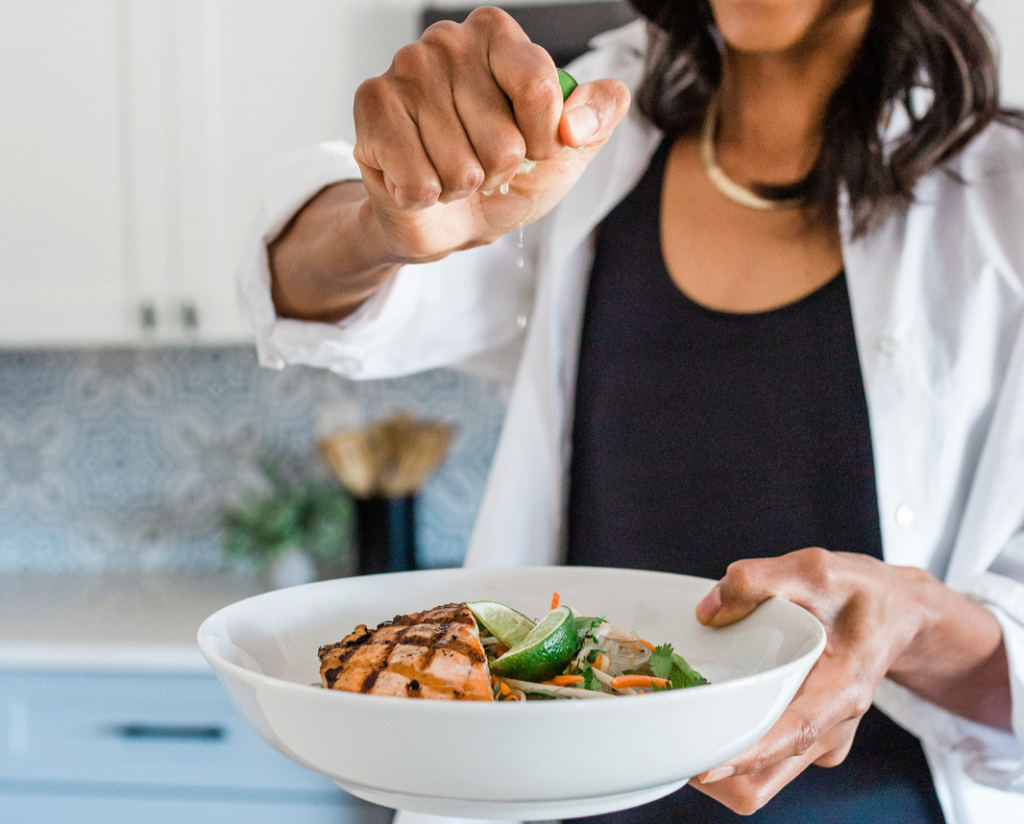A 2020 study showed that inadequate and prolonged calorie intake might lead to hormonal issues, gastrointestinal disturbances, impaired cardiac function, decreased bone health, and, most importantly, impaired performance in athletes.
Having a game plan for fueling is necessary to ensure you are optimizing your performance and not underfueling. As the saying goes, “if you fail to prepare, be prepared to fail.”
Meal Planning Guide
Okay, so you are ready to bring your training to the next level with your newfound Bobby Flay cooking ambition, but maybe you don’t know where to start. No worries, we got you!
I suggest you look at your schedule and find time to plan. This is a crucial step! A typical day for people to do their meal planning is light-training/off-days or Sunday afternoons. Book it like an appointment!
Once you have decided on a day, here are the top 6 steps to knocking out some performance-packed meal planning. But, first, get your pen and paper ready!

1. Prioritize Protein
Protein is sometimes the more tricky macronutrient to plan when compared to carbohydrates and fat. They may take a bit more time to cook, preferences for a particular protein could fluctuate from day to day, and sometimes there are cost increases.
So, choosing your proteins first is a good starting point when meal planning.
Unsure about what falls in this category? I have listed a few below!
Once you have decided on a few proteins, the next step is deciding how to prepare them.
Evaluate what you have available in terms of equipment and flavors. Cooking protein in a crockpot is always easy, but you can also cook stovetop, bake, air fry, or use a grill. Consider what spices you like and how you will season your protein.
2. Plan Your Produce
My first suggestion in planning what produce to pair with your proteins is to scan before you plan! Produce CAN be spendy, but it doesn’t have to be. Scan your local grocery store ads to find what is on sale and plan around that. I recommend getting 3-4 options for both vegetables and fruits.
Are you dealing with some buyers’ anxiety? Here are some tips for navigating the produce options for nutritional value, flavor, and convenience.
- Frozen and fresh is best! Both options are harvested at peak ripeness and have a minimal nutrient loss in processing.
- Choose what is in season and on sale for the best flavor and budget-friendliness.
- Add variety and eat the rainbow! More color = more variety in nutrients!
- Canned produce like marinara, beans, and vegetables are good to have in your pantry for quick meals.
Once you have nailed down your produce of choice, decide how to prepare it.
Some suggestions include steaming, baking, air-frying, or sauteing. Maybe you will decide to have salads? In this case, what dressing and additional toppings will you want?
Preparing veggies with dynamic oils such as olive oil or canola oil can boost the flavor and functionality of the dish as a whole!
3. Choose your Starches
When choosing your starches, be creative! Whole grain products such as bread, potatoes, rice, and pasta are all starches, but items like cassava, plantains, or butternut squash are a few of many fun options that should be included in a balanced diet!
Benefits of starches include added fiber, more vitamins, and minerals, which can translate to better performance.
- Look for “whole grain” as the first ingredient when buying grains
- Make sure added sugar is not one of the first five ingredients
- Choose items with greater than 3g of fiber per serving (we want to limit fiber if right before a competition, though)
- Choose a variety! (rice, pasta, bread, quinoa, tortillas, Kodiak cakes, cassava, buckwheat, butternut squash, potatoes, plantains, etc.!)

Starches are simple to cook in bulk and usually keep well in the fridge. Experiment with new starchy products to see what works best for you.
4. Don’t Forget the Fats
Fat can sometimes get a stigma for being “bad,” but it is pretty essential to include fat in your diet for absorbing fat-soluble vitamins, hormone production, and helping the body recover after strenuous exercise.
Some fats are better than others, though, and the best fats to include are unsaturated, polyunsaturated, and monounsaturated fats. These are typically better than saturated fats because they positively impact the lipid levels within our body, leading to decreased risk of cardiovascular disease, obesity, and other diseases.
You can easily include fats in your meals as a part of dressings, sauces, flavor boosters, or even as a protein-fat duo.
5. Have Emergency Snacks
This step is so important! Ensure you have emergency protein, carbs, and fat in stock for smart snacking. Of course, you don’t have to contribute to your emergency stock every single shopping trip, but if there are some good emergency snacks on sale, plan to stock up!

Sweets are okay to include in your emergency stock! Allowing yourself to have a sweet treat when you want one can save you from binging episodes later and contribute to a positive relationship with food.
6. Plan your Grocery List
Once you have planned the meals and snacks out, have a list ready to go before you hit the store! Having a list will save you time in the store and money from buying unnecessary ingredients.
Planning ahead of time is also a sure way to ensure you have everything! There is nothing worse than getting ready to cook and realizing you forgot potatoes, instant vibe killer!
Putting it All Together
Meal planning, check! Grocery shopping, check! All that’s left is to cook it up!
If you are worried about keeping up with the meal prep Joneses, don’t panic.
The meals you prepare don’t have to be perfect, individually packed, or magazine cover ready. Do whatever works best. I prepare my food in bulk and refrigerate it in large containers. However, some people prefer packaging their meals in small containers.
If you need some tips on the cooking part, we have an in-depth webinar you can check out HERE or a short and sweet prep tutorial video HERE.
Need some pairing ideas? Some of my favorite and easy meal pairings when prepping can include:
- Whole grain spaghetti, ground beef with marinara, and fruits and veggies
- Grilled chicken quesadilla on a whole-grain tortilla with fruits and vegetables
- Eggs with Kodiak cakes, fruit, and spinach
- Wild rice, Brussels sprouts, and shredded chicken with fruit
- Avocado whole-grain toast with eggs, fruit, and vegetables
Case in Point
Take time to prepare; you will thank yourself later. More often than not, reasons for not-so-great nutritional choices are caused by a lack of preparation. It is so much easier to stop at Mcdonald’s or fast food joints when you are SO HUNGRY and know that nothing is prepared at home.
If you care about bettering yourself, improving your performance, and decreasing your risk of injury, we urge you to try meal planning to fuel correctly!
For more optimal nutrition for your specific sport, division level, and training, consult with us to get the best and most in-depth recommendations fit for you and your goals.






